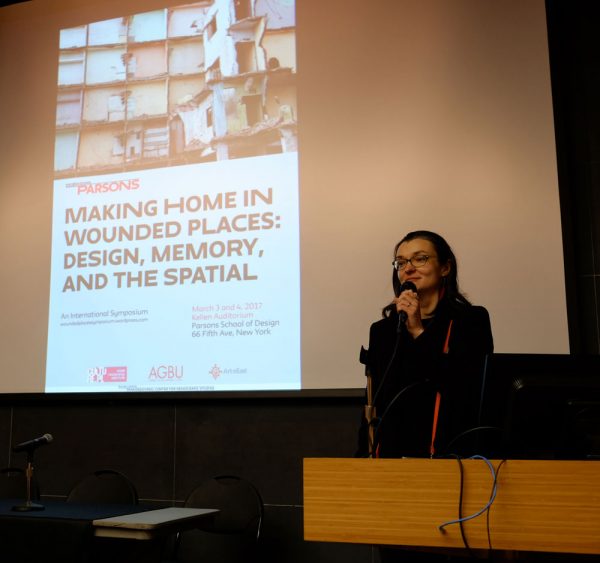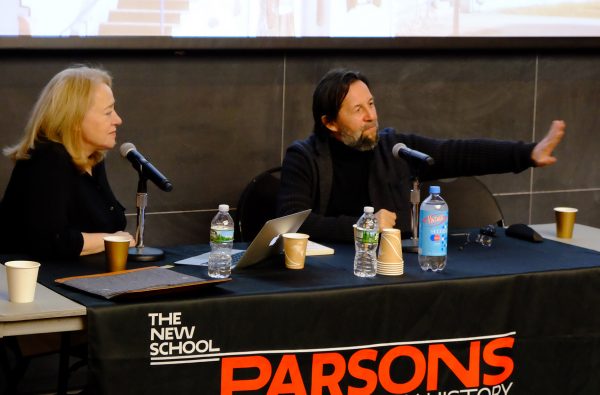Making Home in Wounded Places: Design, Memory, and the Spatial
Highlights by Mariann Asayan and Kayla O’Daniel
Annual MA Design Studies Symposium
organized with New School colleagues
On March 3rd and 4th, 2017, artists, scholars, designers, and activists from around the world gathered to discuss a very timely subject matter: making home in wounded places. The organizers—Susan Yelavich, Associate Professor Design Studies, Director MA Design Studies, Parsons; and Malgorzata Bakalarz Duverger, Sociology PhD candidate, New School for Social Research—defined wounded places as “sites of conflict and natural disasters; places marked by layers of turmoil and conquests; impromptu refuge locations that become permanent.” Throughout the symposium, speakers told stories of how people are making home in these places and how these places are appropriated by the politics of memory.
Day One
The symposium opened with Susan Yelavich making the statement that design is social and a matter of time and space, and thus, a matter of memories. Yelavich’s opening remarks became the basis for discussion as the audience became aware of the effects of design on social, political, and memory power. Panel one focused the conversation around appropriations of spaces wounded by history. In this panel, speakers presented a series of vastly different places, all of which had—through historical acts—become wounded landscapes. These places, while affected by social and political powers of the past, became the home for future generations. It is how these future generations appropriate the space that becomes significant. Although a place is wounded, it does not mean its citizens have to live in wounded manner.

Virginia Tassinari and Clive Dilnot opened up the conversation around states of exception as moments of possibility for design. Tassinari posed the notion that states of exception can be the basis for imagining a more inclusive, more righteous society, in which citizens can play a key role in establishing positive change. She brought up the idea of oases, the in-between spaces where politics lie in the public realm and can no longer be considered a paid profession. In these spaces, power becomes a form of discourse and opens up laboratories of thought and resistance. Dilnot added that “states of exception,” understood in terms of design, should also serve as prototypes for new systems, or as he put it, “stereotypes,” citing a modernist clinic in 1930s Britain that presaged the National Health Service.
The second panel revolved around the politics of commemoration, discussing wounded places that hold the power to invoke memory and resistance. Yukiko Koga made the claim that wounded places are often inherited, carrying scars of the past. Panel three built on this discussion, theorizing the palimpsests of wounded places. Through both Jonathan Bach and Adam Lipszyc’s talks, the conversation moved toward places that are reconstructed in an attempt to erase the memory of the past, but which still hold power to invoke memory. Lipszyc noted that every inhabited space is always haunted by the past, both our own and other people’s.

Day one ended with a powerful story from keynote speaker, Lina Sergie Attar. Attar is the co-founder and CEO of Karam Foundation, which has developed innovative education initiatives of creative therapy and holistic wellness for displaced Syrian children. She discussed the story of Syria and its people who have experienced the destruction of their country. Taking into account her personal experience, Attar considered how designers can reexamine the past to envision the possibilities for the future. It is not the destruction and the scars of these places that define its people, it is their drive to overcome them. —Kayla O’Daniel
Day Two
The idea that design has the responsibility to open the doors of possibilities was the mantra of day two. It was expressed as presenters explored engaging with the wounded and treating the scarred. Krzysztof Czyżewski, a social activist, founder and director of the Borderland Foundation, and a “practitioner of ideas,” engaged in a conversation with Elżbieta Matynia. Together they discussed his work in Sejny, Poland—a three-decade long project of reconciliation among splintered peoples.

We have always been concerned with our safety as people, communities, and states, but Czyżewski, explained that our safety has been addressed improperly. We have been assured that the fence or the fortress is what will protect us. This is not the case. It is the bridge—and through it, the connection and relations with other humans—that will serve as true protection.
Otto von Busch picked up on this message in the first panel as he questioned the panelists, asking, “How does the designer work in the world?” If the designer only works to alleviate pain, does this interfere with the ability to feel pain in the first place? Will we or have we already created a community that can no longer deal with pain? Angeliki Dimaki-Adolfsen had one answer on how to work in the world with her research project “Children Let’s Play.” The project explores how children can utilize play to help “further their individual and social capabilities” in refugee camps. Dimaki-Adolfsen stated that spontaneity has the potential to enable action, agency, and resistance, and therefore the spontaneity of children’s play must be considered an empowering tool. The ingenuity of Dimaki-Adolfsen’s case study revolves around utilizing a pre-existing structure to achieve more desirable outcomes, which begs the question, what else can be re-oriented to enable agency?
Barbara Adams also focused on the act of re-orientation. Adams opened up the conversation further by raising questions of the appropriateness of designers’ interventions in challenging social circumstances. When we come face to face with work that is meant to engage the viewer with the refugee we must not lose our criticality. Is the work promoting empathy or pity? Are we talking about people or “those people”? Adams questioned if designers might be able to flip this script.
The final panel looked at personal responses to wounded spaces and difficult histories. Nora Krug shared images and text from her visual memoir Belonging (tentative title). The memoir deals with her experience as a German national born well after the end of World War II. From her excerpt, we learned of an uncle who grew to be an ideal child of Nazi Germany. This moral and identity struggle became the omnipresent theme of the piece. From her reading, the audience gained further understanding of what it means to be from a wounded place and how far its temporal repercussions reach. We consider those who come from wounded places as victims, but what does it mean to not be the victim and still feel the wound?

To be a designer in times of turmoil can often be discouraging. Yet by the end of the weekend it was difficult to not see a potential for change. The symposium ended with empowering words by Susan Yelavich, who said, as long as those in wounded places try to make a home, we must give them the power and agency to do so. —Mariann Asayan
The symposium was a collaboration of Parsons MA Design Studies program, the New School Global Studies program, the Transregional Center for Democratic Studies, New School for Social Research. It was made possible by the Adam Mickiewicz Institute, the Armenian General Benevolent Union, and ArteEast.
Photographs by Leticia Cartier Oxley and Irem Yildiz
Author Affiliations
Mariann Asayan
MA student, Design Studies, Parsons School of Design
Kayla O’Daniel
MA student, Design Studies, Parsons School of Design

 DESIGN STUDIES BLOG
DESIGN STUDIES BLOG

